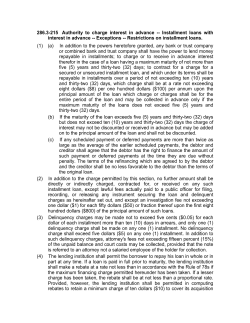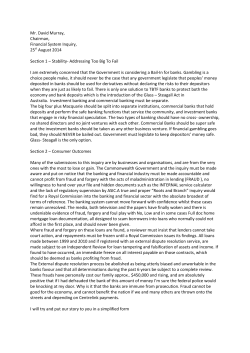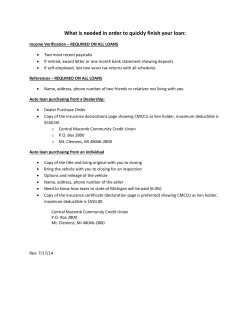
2014 Federal Interagency Fair Lending Hot Topics
10/17/2014 2014 Federal Interagency Fair Lending Hot Topics Outlook Live Webinar – October 22, 2014 Visit us at www.consumercomplianceoutlook.org 1 Overview • Fair Lending Updates – Anna-Marie Tabor, Deputy Fair Lending Director, Office of Fair Lending and Equal Opportunity, Consumer Financial Protection Bureau • Risk-Based Approach to Fair Lending – Tara L. Oxley, Chief, Fair Lending and CRA Examinations, Federal Deposit Insurance Corporation • Fair Lending Risk Assessments – Kimberly G. Hebb, Director for Compliance Policy, Office of the Comptroller of the Currency • Expectations for Compliance Management Systems – Jamie Goodson, Director, Division of Consumer Compliance Policy and Outreach, Office of Consumer Protection, National Credit Union Administration 2 Overview • Target Pricing for Mortgages: An Emerging Fair Lending Risk – Maureen Yap, Special Counsel/Manager, Fair Lending Enforcement Section, Division of Consumer and Community Affairs, Federal Reserve Board • Recent Enforcement Actions: REO Properties and Maternity Leave – Karina S. Leake, Equal Opportunity Specialist, Office of Systemic Investigations, U.S. Department of Housing and Urban Development • Auto Lending Enforcement – Marta Campos, Trial Attorney, U.S. Department of Justice, Civil Rights Division, Housing and Civil Enforcement Section 3 1 10/17/2014 Fair Lending Updates Anna-Marie Tabor, Deputy Fair Lending Director Office of Fair Lending and Equal Opportunity Consumer Financial Protection Bureau 4 CFPB’s Office of Fair Lending and Equal Opportunity Fair Lending means: “fair, equitable, and nondiscriminatory access to credit for consumers” Our Fair Lending activities and responsibilities include: • Fair Lending Supervision and Enforcement – Providing oversight and enforcement of Federal fair lending laws • Rulemaking – Working with CFPB’s Office of Regulations on fair lending rulemakings • Outreach - Promoting fair lending compliance, education and reporting • Interagency Coordination – Coordinating fair lending efforts with Federal agencies and State regulators 5 Topics • Auto Updates • Mortgage Updates • HMDA Rulemaking 6 2 10/17/2014 Auto Updates • Supervisory Highlights: Summer 2014 • Proxy methodology paper • Proposed rule defining larger participants in auto finance market 7 Indirect Auto Lending and Fair Lending Risk • Standard policies/practices of indirect auto lenders often make them “creditors” under ECOA • Allowing dealers discretion to increase consumer interest rates is a source of fair lending risk • The CFPB evaluates possible discrimination in both auto lending and in other markets on a case-by-case basis • Dealers deserve to be fairly compensated for adding value and finding financing 8 Indirect Auto Lending: Methods for Mitigating Fair Lending Risk 1. Compliance Management Systems (CMS) – Up-to-date fair lending policy statement – Regular fair lending training – Ongoing monitoring for compliance with fair lending and other policies and procedures – Review of lending policies for potential fair lending violations – Statistical analysis, depending on the size and complexity of the institution – Regular assessment of marketing of loan products – Meaningful oversight of fair lending compliance 9 3 10/17/2014 Indirect Auto Lending: Methods for Mitigating Fair Lending Risk (continued) 2. Limits on maximum allowable discretionary pricing adjustments 3. Dealer compensation not based on discretionary markup For more information, see: Supervisory Highlights: Summer 2014 10 CFPB’s Proxy Analysis Surnames For more information, see: • proxy methodology paper and the • statistical software code used to build the proxy Proxy Analysis Geocoding Institutionspecific loan data 11 Proposed Larger Participant Rule to provide more complete oversight of the auto finance market • Nonbank auto finance companies that make, acquire, or finance 10,000 or more loans and/or leases in a year • About 38 auto finance companies, which originate around 90% of nonbank auto loans and leases, and in 2013 provided financing to approximately 6.8 million consumers • CFPB wants to ensure auto lenders are treating consumers fairly throughout the life of a loan or lease by: – Fairly marketing and disclosing auto finance – Providing accurate information to credit bureaus – Treating consumers fairly when collecting debts For more information, see the proposed rule 12 4 10/17/2014 CFPB’s ECOA Targeted Mortgage Reviews • CFPB’s mortgage supervision program has included ECOA Targeted Reviews at institutions that receive about 40% of the applications and make about 40% of the originations reported pursuant to HMDA • Institutions are identified for ECOA Targeted Mortgage Reviews through a risk-based prioritization process • ECOA Targeted Mortgage Reviews generally include: – Statistical analysis of HMDA and additional fields – Review of policies and procedures for ECOA and Regulation B compliance – Loan file reviews 13 Issues Identified in Supervisory Reviews • CFPB examination teams have observed various factors that indicate heightened fair lending risk, including: – Policies that consider prohibited bases in a manner that violates ECOA or presents a risk of a fair lending violation – Discretionary policies without sufficient controls or monitoring to control fair lending risk – Insufficient documentation for pricing and underwriting exceptions – Data inaccuracies that impair the institution’s fair lending self-assessments 14 HMDA Proposed Rule The Dodd-Frank Act expanded the scope of data collected and submitted under HMDA: • • • • Age of applicant Rate spread (for all loans) Credit score Non-fully amortizing payment features • Total points and fees • Prepayment penalty term • Property value • Period after which the rate may change • Loan term • Application channel • As appropriate, identifiers for loan originators, loans, and property parcels • Other information, as the CFPB may require 15 5 10/17/2014 HMDA Proposed Rule (continued) The CFPB’s HMDA rulemaking notice proposed additional HMDA data points including: • Debt-to-income (DTI) ratio • Qualified mortgage (QM) status of the loan • Combined loan-to-value (CLTV) ratio • Automated underwriting systems results • Pricing information including total origination charges; total discount points; risk-adjusted, pre-discounted interest rate; and interest rate • Multifamily housing data • Manufactured housing data Comment period ends October 29, 2014. Submit your comments at http://www.regulations.gov/#!submitComment;D=CFPB-2014-0019-0001 16 Online Fair Lending Resources • Each institution should ensure that its CMS is tailored to its operations; scope, size and complexity may vary • For more information, review the following resources available on our website: www.consumerfinance.gov • Supervision and Examination Manual (and other guidance documents) • Supervisory Highlights: Summer 2014 • Proxy Methodology White Paper • Proxy Statistical Software Code • • • • Lending Discrimination Bulletin HMDA Bulletin Auto Lending Bulletin Responsible Business Conduct Bulletin • Fair Lending Report • Auto Finance Field Hearing 17 Consumer Resources Ask CFPB • Ask CFPB is an interactive online tool that gives consumers answers to more than 1,000 questions about financial products and services, including credit cards, mortgages, student loans, bank accounts, credit reports, payday loans, and debt collection at www.consumerfinance.gov/askcfpb Consumer Complaints • To submit a complaint about a consumer financial product or service, consumers can visit: www.consumerfinance.gov/complaint or call 855-411-CFPB (2372). The CFPB can assist consumers in over 180 languages 18 6 10/17/2014 The FDIC’s Risk-Based Approach to Fair Lending Tara L. Oxley, Chief Fair Lending and CRA Examinations Federal Deposit Insurance Corporation 19 Preparing for a Fair Lending Review • Examiners request information prior to the start of an examination • This information is used to evaluate fair lendingrelated risks • This risk analysis will guide the scope and focus of the fair lending review 20 Assessing Fair Lending Risks • Examine using a risk-based methodology • Evaluate the bank’s structure, operations, and compliance management system • Identify institutional inherent risks • Determine whether other factors help mitigate risk 21 7 10/17/2014 Conducting Focused Reviews • After evaluating an institution’s inherent risk and mitigating factors, examiners may decide a more indepth analysis is needed • Examiners will keep a bank updated throughout the process • An institution will have the opportunity to respond before the FDIC makes a final determination 22 Reference Materials • FDIC’s Fair Lending Scope and Conclusions Memorandum • FFIEC Interagency Fair Lending Examination Procedures 23 Fair Lending Risk Assessments Kimberly G. Hebb, Director for Compliance Policy Office of the Comptroller of the Currency 24 8 10/17/2014 Lifecycle of a Credit Product Loan Product Features Marketing Loan Application Delivery Channels Underwriting Pricing Originator Compensation Servicing (including loan modifications & foreclosures) 25 Consequences of Lending Discrimination • • • • • • • Lost opportunities Complaints and lawsuits Negative publicity Public protests Regulatory scrutiny Negative impact on CRA ratings Referral to the Department of Justice / Department of Housing & Urban Development • Business constraints, restitution, and civil money penalties 26 Fair Lending Risk Assessment • Review fair lending risk under ECOA and FHA • Granular approach – identify risk at product level • Product types – – – – – – Home mortgage Home equity loans & lines of credit Consumer loans Credit cards Modifications/loss mitigation Business purpose 27 9 10/17/2014 Fair Lending Risk Assessment (continued) • Product features – Portfolio, purchased, government-backed, traditional saleable, alternative • Delivery channels – Branch, loan production office, phone/mail, preapproved, internet, mobile, third party • Underwriting – Centralized/decentralized, credit scoring, judgmental, third party underwriting, exceptions 28 Fair Lending Risk Assessment (continued) • Pricing – Standard across institution, regional, risk-based, discretionary • Marketing – Standard in and across AAs/markets, targeted demographic advertising, special purpose programs, direct mail campaigns, branch level • Originator compensation – Flat fee, straight salary, volume/percentage of loans, terms, portfolio growth/performance, referral 29 Fair Lending Risk Assessment (continued) • Reputation risks – Complaints, “Needs to Improve” ratings, CRA AAs, litigation, referrals to other agencies • Supervisory concerns – Violations, MRAs, institution-identified issues, fair lending issues identified by other supervisory agencies, previous supervisory activities 30 10 10/17/2014 Fair Lending Risk Assessment (continued) • Risk Management / Controls – Policies/Procedures – Training – Audit/Compliance Testing – Self-Evaluation – Resources 31 Expectations for Compliance Management Systems Jamie Goodson, Director Division of Consumer Compliance Policy and Outreach Office of Consumer Protection National Credit Union Administration 32 Elements of an Effective Compliance Management System • • • • • • Board of Directors and Management Oversight Policies and Procedures Training Monitoring/Testing and Corrective Action Compliance Audit Member Complaint Response 33 11 10/17/2014 Board of Directors and Management Oversight • Demonstrate clear expectations about fair lending compliance within the institution and by third party service providers • Adopt clear policy statements about fair lending compliance • Define clear responsibilities for fair lending compliance management • Allocate resources appropriate for the institution’s size and complexity • Implement a fair lending audit function appropriate for the institution’s size and complexity 34 Policies and Procedures • • • • Document policies and procedures Include sufficient detail Review and update frequently Cover all loan products and phases, such as advertising, marketing, underwriting, servicing, loss mitigation, and third party oversight • Address reviews done before the institution introduces new lending products or modifies existing products, including— – Evaluation of documents and disclosures – System testing – Staff training 35 Training • Educate board of directors, management, staff – Board of directors should receive sufficient information to understand responsibilities and resource requirements – Management and staff should receive specific, comprehensive training that reinforces and helps implement written fair lending policies and procedures • Address new and existing employee training • Maintain a fluid schedule – Cover regulatory changes – Address observed weaknesses or noncompliance 36 12 10/17/2014 Monitoring/Testing and Corrective Action • Schedule and complete monitoring and testing • Determine compliance with policies and procedures • Consider the results of internal or external audits, risk assessments, or other guidelines • Document who monitored what and when • Escalate findings to management and the board of directors if appropriate • Take prompt corrective action if appropriate 37 Compliance Audit • • • • • • Fair lending risk assessment Comparative file reviews HMDA analysis Evaluation of underwriting and pricing parameters Demographic analysis Review of— – – – – Exception and override reports Fair lending policies and procedures Fair lending training Marketing and advertising practices 38 Complaint Response • Be responsive • Be responsible • Organize, retain, and use complaint information 39 13 10/17/2014 NCUA Fair Lending Resources NCUA Fair Lending Guide Additional Resources • • • • • • Best Practices FAQs Regulatory Alerts Webinars HMDA Resources Interagency Fair Lending Examination Procedures 40 Target Pricing for Mortgages An Emerging Fair Lending Risk Maureen Yap, Special Counsel/Manager Fair Housing Enforcement Section Division of Consumer and Community Affairs Federal Reserve Board 41 The Federal Reserve’s Fair Lending Authority Federal Reserve CFPB SMB above $10B Fair Housing Act (FHA) Equal Credit Opportunity Act (ECOA) SMB of $10B or less FHA, ECOA • The Federal Reserve Board (Board) supervises: – Over 800 state member banks (SMBs) – SMBs above $10B for compliance with the FHA – SMBs of $10B or less for compliance with the FHA, ECOA and Regulation B • The Consumer Financial Protection Bureau (CFPB) supervises: – Institutions above $10B for compliance with the ECOA and Regulation B • Thus, the Federal Reserve and the CFPB share supervision authority for fair lending in mortgages for SMBs above $10B 42 14 10/17/2014 Federal Reserve Referrals • Pursuant to the ECOA, if the Board has reason to believe there is a pattern or practice of discrimination, the Board must refer the matter to the U.S. Department of Justice (DOJ) • The Federal Reserve has referred a number of matters to the DOJ, including matters regarding: Pricing o o o o Mortgages Indirect Auto Lending Unsecured Loans Mortgage Discount Points (Fair Lending and UDAP) Redlining Underwriting o Maternity Leave Discrimination o Disability/Public Assistance Discrimination Spousal Signatures Credit Reporting 43 Federal Reserve Pricing Reviews • Federal Reserve examiners conduct fair lending pricing reviews as part of consumer compliance exams – Based on the 2009 Interagency Fair Lending Examination Procedures, examiners will look for the following risk factors: Policies or procedures that indicate discretion in pricing and/or exceptions Financial incentives based on the terms or conditions of the loan Loan data that indicates pricing disparities on a prohibited basis Complaints 44 Target Pricing for Mortgages: An Emerging Fair Lending Risk Overview • Some banks are setting a different target price (interest rate and fees) for each mortgage loan originator to offer to consumers • Fair lending risks can arise if the high-price mortgage loan originators are concentrated in minority areas • The Federal Reserve has had one referral on this issue 45 15 10/17/2014 Target Pricing – Regulation Z • Since April 2011, Regulation Z’s mortgage loan originator (MLO) compensation rule has prohibited a bank from paying a loan officer based on the terms or conditions of the loan, including the price. This reduces the fair lending risk at the MLO level • However, the fair lending risk for mortgage pricing is not eliminated • Nonproducing managers, branches, and the bank may still derive compensation or profit based on the price of the loan, and some Regulation Z-compliant models can significantly increase fair lending risk 46 Target Pricing – The “Target Price” • Target Price: Some banks that originate loans for the secondary market now set a “target price” for each MLO, which can be calculated with any combination of a higher interest rate and/or discretionary fees • Compensation Plan: The MLO is paid a fixed percentage of the loan amount. Thus, the compensation plan may comply with Regulation Z • Software: Some banks reinforce the target price for the MLOs by using software that only shows the MLO the interest rate and fee options based on their approved target price 47 Target Pricing – Interest Rate Example • The investor sets a “par” interest rate that generates a net investor price of “100.” The par interest rate is already adjusted for risk based on the credit characteristics of the borrower • An MLO with a target price of “101” must generate revenue equal to 1% of the loan amount through any combination of interest rate and fees • To reach the target price and generate higher profits to the bank using the interest rate, the MLO can charge the borrower the interest rate available at an investor price of “101” • The additional interest rate (or “overage”) is not based on the borrower’s credit characteristics 48 16 10/17/2014 Target Pricing – Fee Example • An MLO with a target price of “101” must generate revenue equal to 1% of the loan amount through any combination of interest rate and fees • To reach the target price and generate higher profits to the bank using fees, the MLO can charge the borrower discretionary fees equal to 1% of the loan amount • The additional discretionary fees (or “overage”) are not based on the borrower’s credit characteristics 49 Target Pricing – Combined Interest Rate and Fees Example • An MLO with a target price of “102” must generate revenue equal to 2% of the loan amount through any combination of the interest rate and fees MINIMUM PRICE OVERAGE Par Interest Rate (“100”) Interest Rate Above Par (“101”) + + Required Fees Discretionary Fees (1% of Loan Amount) TARGET PRICE (“102”) 50 Target Pricing – Fair Lending Risk • • Fair lending risk arises if MLOs with higher target prices are concentrated in minority neighborhoods. These higher target prices will be based solely on discretion at the bank level and not on the credit characteristics of the borrower. That is, a loan made at the 103 target price could have been made to the same borrower at the 101 target price For example: MLO-A MLO-B Target Price 101 103 Customer Base Mostly NonMostly Hispanic Hispanic Borrowers Borrowers 51 17 10/17/2014 Target Pricing – Fair Lending Risk (continued) • Hispanic applicants dealing with mortgage loan originator B, who has a 103 target price, will always receive a higher price than similarly-situated nonHispanic applicants dealing with loan originator A, who has a 101 target price • This scenario can lead to statistically significant, unexplained disparities in pricing (APR, interest rate, fees, overages) 52 Target Pricing – Best Practices • Banks that set target prices for MLOs should: – Review the MLO compensation plan for compliance with Regulation Z – Recognize that setting different target prices for MLOs raises fair lending risks – Monitor pricing by race/ethnicity across MLOs, including the APR, interest rate, fees, and overages; use statistical analysis if there is sufficient volume – Recognize the risk of potential reverse redlining where high-price MLOs are concentrated in minority neighborhoods; consider mapping loans by target price 53 Resources • Consumer Compliance Outlook – Federal Reserve publication dedicated to consumer compliance • Outlook Live – Federal Reserve webinars on consumer compliance topics • Community Banking Connections – Federal Reserve publication and website dedicated to providing guidance, resources and tools for community banks • Interagency Fair Lending Examination Procedures and Appendix 54 18 10/17/2014 Recent Enforcement Actions: REO Properties and Maternity Leave Karina S. Leake, Equal Opportunity Specialist Fair Housing and Equal Opportunity Office of Systemic Investigations U.S. Department of Housing and Urban Development 55 Maintaining and Marketing REO Properties • The Department of Housing and Urban Development has ongoing investigations into lenders’ maintenance and marketing of REO properties • The lenders being investigated are alleged to have maintained and marketed foreclosed homes in majority white neighborhoods in a much better manner than in majority African-American or Hispanic neighborhoods 56 REO Maintenance • • • • • Structure—broken windows, unsecured doors… Curb appeal—trash, overgrown grass, accumulated mail… Water damage—mold, damaged roof… Paint—graffiti, peeling paint… Gutters—missing, damaged… REO Marketing • Missing or broken “For Sale” sign • Marketed as distressed property • Visible foreclosure signage 57 19 10/17/2014 Wells Fargo REO Settlement June 2013 HUD entered settlement with Wells Fargo regarding the maintenance and marketing of its bankowned homes • Result of a complaint filed in April 2012 with HUD • Complaint alleged Wells Fargo’s bank-owned properties in White areas were much better maintained and marketed than such properties in African-American and Latino neighborhoods • Agreement between Wells Fargo, National Fair Housing Alliance, and HUD total $42 million 58 Wells Fargo REO Settlement (continued) Wells Fargo will provide $38.5 million to fair housing organizations in 19 cities for: • Promoting homeownership • Neighborhood stabilization • Property rehabilitation • Development in communities of color 59 Wells Fargo REO Settlement (continued) • Wells Fargo will implement best practices for the maintenance and marketing of their REO properties • Enhance its First Look program • Make it easier for the public to get information about its REO properties • Develop an enhanced fair housing training program on REO issues for its employees 60 20 10/17/2014 REO Best Practices • Hire local vendors, preferably in the subject community, to perform preservation and maintenance services • Check! Check! Check! Set standards and inspect what you expect from vendors hired to perform preservation and maintenance services 61 REO Best Practices (continued) • Partner with local fair housing agencies to sell REOs to people who will occupy the properties rather than to investors • Sell REO properties to fair housing agencies for community use • Offer alternative financing solutions: – Provide access to flexible capital for acquisition and rehabilitation – Offer alternatives to permanent financing for low balance loans or credit challenged buyers 62 Maternity Leave and Fair Lending Issues • • • • • • • Sex Familial status Pregnancy Securing legal custody of child under age of 18 Maternity or paternity leave status Disability Medical complications related to pregnancy 63 21 10/17/2014 Maternity Leave and Fair Lending Violations Discriminatory Statements or Terms • Lender says it cannot approve or fund the loan due to maternity leave status • Lender says it cannot use maternity leave related income to underwrite the loan 64 Wells Fargo Maternity Leave Settlement • September 2014 – $5 million total • The six complainant households receive a total of $165,000 in damages • The agreement includes a victims fund of up to $5 million, with each claimant to receive up to $20,000 per household • Unspent funds in the victims fund will go to support fair housing organizations • Wells Fargo adopted a national temporary leave policy that is consistent with the requirements from Fannie, Freddie and FHA 65 Maternity Leave Underwriting Best Practices • Lenders should adopt a written maternity leave underwriting policy that includes the following: – Mortgage applicant is not required to return to work before closing – Mortgage applicant on maternity leave is considered employed – Lender must not ask mortgage applicant about future maternity leave plans 66 22 10/17/2014 U.S. Department of Housing and Urban Development 1-800-669-9777 to report housing discrimination www.hud.gov 67 Auto Lending Enforcement Marta Campos, Trial Attorney U.S. Department of Justice Civil Rights Division Housing and Civil Enforcement Section 68 DOJ Auto Lending Enforcement • United States v. Auto Fare, Inc., et al. (W.D.N.C.) • United States v. Ally Financial Inc. and Ally Bank (E.D. Mich.) • United States v. Nara Bank and Union Auto Sales (C.D. Cal.) • United States v. Pacifico Ford, Inc. and United States v. Springfield Ford, Inc. (E.D. Pa.) • Amicus brief in Cason v. Nissan Motor Acceptance Corp. (M.D. Tenn.) 69 23 10/17/2014 United States v. Ally Financial Inc. and Ally Bank (2013) • Formerly GMAC • One of the nation’s largest auto lenders • November 2013 referral from CFPB • Investigation conducted jointly with CFPB 70 United States v. Ally Financial Inc. and Ally Bank (2013) (continued) • Complaint alleged Ally charged minority borrowers higher interest rate markups on indirect auto loans • Dealers granted broad and subjective discretion by Ally to mark up buy rate, subject to caps • Ally did not conduct sufficient monitoring to detect race or national origin disparities 71 United States v. Ally Financial Inc. and Ally Bank (2013) (continued) • Statistical disparities: – African-Americans: 29 bps – Hispanics: 20 bps – Asian/Pacific Islanders: 22 bps *99% confidence level • DOJ and CFPB used Bayesian Improved Surname Geocoding (BISG) proxy methodology to estimate race and national origin 72 24 10/17/2014 United States v. Ally Financial Inc. and Ally Bank (2013) (continued) • December 2013 settlement • $80 million settlement fund • $18 million civil monetary penalty to CFPB • Ally must refund discriminatory overcharges for the next three years unless disparities significantly reduced • New CMS to monitor for disparities 73 United States v. Auto Fare (2014) • Defendants operate “Buy Here Pay Here” auto dealerships, providing direct financing for used cars • Customers are only required to make down payment and prove residency and income • Joint investigation with NC DOJ • Complaint filed January 2014 74 United States v. Auto Fare (2014) (continued) • Complaint alleges that defendants targeted borrowers for predatory loans without meaningful assessment of creditworthiness • Predatory loan features: – Excessive sales price – Very high down payment – Disproportionately high APR 75 25 10/17/2014 United States v. Auto Fare (2014) (continued) • Complaint alleges that African-American borrowers were targeted for predatory loans • Complaint alleges owner used racial slurs and epithets and made derogatory statements about African-American customers • Many of defendants’ customers defaulted and/or had vehicles repossessed 76 Want more information? • Former AAG Tom Perez testified about fair lending before Senate Judiciary Committee: http://www.justice.gov/crt/opa/pr/speeches/2012/cr t-speech-120307.html • All fair lending complaints and settlements are on HCE’s website: http://www.justice.gov/crt/about/hce/caselist.php 77 Questions? 78 26
© Copyright 2025









